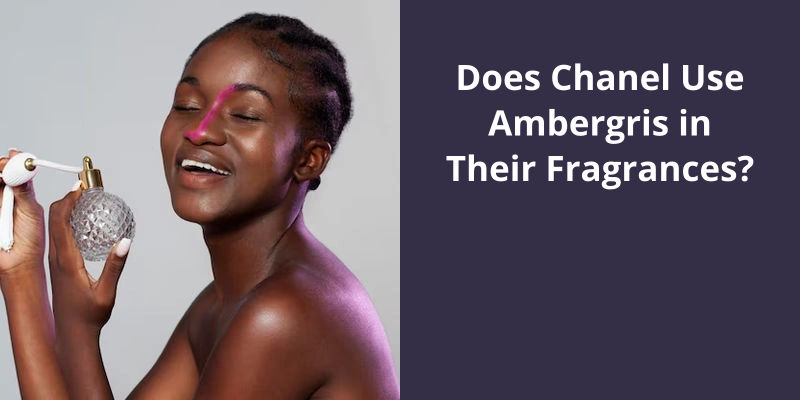Chanel, a prominent fashion and fragrance house, does not publicly disclose the complete list of ingredients used in their fragrances, presumably due to trade secrets. This makes it difficult to confirm whether ambergris, a precious substance traditionally used in high-quality perfumes, is used in their perfume formulations. However, synthetic substitutes for ambergris are commonly used in modern perfumery due to ethical considerations and the rarity of natural ambergris. Therefore, it’s likely that Chanel uses synthetic alternatives, but without official information, this can’t be confirmed absolutely.

Does Chanel Number 5 Contain Ambergris?
The use of animal-derived ingredients in the fragrance industry has been a long-standing debated topic. Some believe that the use of such ingredients is unethical, while others argue that they’re necessary for achieving the desired fragrance profile. In the case of Chanel No. 5, there have been accusations that the perfume contains ambergris, a substance found in the digestive tract of sperm whales.
However, Chanel has never confirmed nor denied the presence of ambergris in their iconic fragrance. It’s speculated that if Chanel did use ambergris in the past, they may have switched to a synthetic alternative due to the controversy surrounding the use of animal-derived ingredients in cosmetics and personal care products.
It’s worth noting that there’s been a surge in consumer demand for cruelty-free and vegan products in recent years, and many companies have adjusted their formulas and production methods to accommodate this trend. Chanel No. 5, as a highly influential and iconic fragrance, may one day follow suit in response to changing consumer preferences and societal values.
Regardless of whether Chanel No. 5 contains ambergris or not, the fragrance has remained a beloved and timeless classic for over a century. It’s signature blend of floral and musky notes has been replicated and imitated countless times, establishing Chanel No. 5 as a true icon in the fragrance industry.
The Controversy Surrounding the Use of Animal-Derived Ingredients in the Fragrance Industry
There’s a debate over whether it’s ethical to use materials from animals in the fragrance industry. This has caused controversy and sparked a discussion about animal welfare and sustainability.
Aside from it’s use in perfumes, ambergris has been utilized for various purposes over the centuries. In fact, this waxy substance derived from sperm whales has been an ingredient in food and drink, as well as medicine. So, what other products have been made from ambergris? Keep reading to find out.
What Products Are Made From Ambergris?
In fact, in ancient times, it was believed to have medicinal properties and was used as a cure for various ailments. Some cultures also used it as an aphrodisiac. Nowadays, ambergris is primarily used in the production of luxury cosmetics, including high-end creams, lotions, and hair products.
In addition to it’s unique scent, it also has a number of other properties that make it desirable for use in cosmetics. For example, it’s antimicrobial and antioxidant properties that can help keep skin healthy.
While the use of ambergris in food and drink isn’t as common as it once was, it’s still occasionally used today. One example is in certain high-end restaurants where chefs may use it to flavor dishes or desserts. It’s also sometimes used in the production of liqueurs and other alcoholic beverages.
Ambergris is harvested from the ocean, where it’s formed in the digestive systems of sperm whales. While it may sound unappetizing, the odor of ambergris changes over time, becoming more complex and pleasant. As a result, the longer it’s been floating in the ocean, the more valuable it becomes.
Overall, while ambergris may not be quite as widely used as it once was, it remains a highly sought after material for luxury products.
The Process of Harvesting and Collecting Ambergris From the Ocean.
- Locate potential ambergris-rich ocean areas
- Collect specimens of whale vomit or excrement
- Perform a float test to determine if the specimen is ambergris
- If confirmed, carefully remove the ambergris from the specimen using a knife or other tool
- Clean and purify the ambergris, removing any impurities such as seaweed or sand
- Dry the ambergris in a well-ventilated area, away from direct sunlight
- Store the ambergris in a cool, dry place until it’s ready to be sold or used
While many perfumes now use synthetic substitutes for ambergris, some still rely on the rare and coveted natural ingredient. Among these fragrances are some iconic classics and newer releases that continue to use ambergris for it’s unique and complex scent profile. Let’s explore some of these perfumes and the role that ambergris plays in their compositions.
What Perfumes Still Use Ambergris?
Ambergris, also known as “whale vomit” is a waxy substance produced in the digestive systems of sperm whales. Despite it’s rather unpleasant origins, ambergris is a prized ingredient in the perfumery industry due to it’s unique scent and longevity.
One of the most iconic ambergris perfumes is Mitsouko by Guerlain. This fragrance was first launched in 1919 and is considered a classic in the world of perfumery. Mitsouko contains notes of peach, jasmine, and oakmoss, but it’s the ambergris that adds a subtle warmth and depth to the fragrance.
Fragrances such as Ambre Nuit by Dior and Ambre Sultan by Serge Lutens are both modern interpretations of the classic ambergris scent. Ambre Nuit is a unisex fragrance that features notes of bergamot, pink pepper, and ambergris. The result is a warm and sensual scent that’s perfect for cooler months. Ambre Sultan, on the other hand, is a spicy and exotic fragrance that features notes of coriander, angelica, and ambergris. This fragrance is perfect for those who want a more intense and complex ambergris perfume.
Ambergris is only produced by sperm whales and is a rare find for perfumers. Additionally, the use of ambergris in fragrances has become controversial due to the unethical treatment of whales. Some perfumers have started to use synthetic versions of ambergris to create similar scents without harming marine life.
From classic scents like Mitsouko to modern fragrances like Ambre Nuit, there’s a wide range of options available. Regardless, there’s no denying the allure of a high-quality ambergris perfume.
Source: Ambergris – Sylvaine Delacourte
As fascinating as the odor of freshly produced ambergris may be, it’s the transformation it’s scent undergoes as it ages that truly captivates those who seek it out. It’s initial marine, fecal odor is gradually replaced by a sweet, earthy fragrance that’s been compared to the clean scent of isopropyl alcohol. But what makes ambergris so sought-after? Let’s delve deeper into it’s unique characteristics.
What Does Ambergris Smell Like?
The scent of ambergris is complex and highly prized in perfumery due to it’s ability to enhance and add depth to other fragrances. The scent is often described as musky, woody, and slightly sweet, with a slightly bitter undertone. In some cases, the scent can also have a slight floral note that adds to it’s overall complexity.
Ambergris produced by sperm whales, for example, tends to have a stronger and more complex scent than that produced by other whale species.
It’s often used as a base note in high-end perfumes, where it helps to enhance and intensify the other scents used in the formulation.
Overall, while the thought of using a substance derived from whale vomit in fragrance may seem strange at first, the unique and complex scent of ambergris has made it a highly sought-after ingredient for centuries.
The History of Ambergris in Perfumery and Medicine
Ambergris is a substance produced in the digestive system of sperm whales and has been used for centuries in perfumery and medicine. It’s unique scent and properties make it a highly sought-after ingredient in high-end perfumes. In traditional medicine, it was believed to have anti-inflammatory and aphrodisiac properties. The use of ambergris in perfumery and medicine has a long and fascinating history that dates back to ancient times.
Conclusion
It raises important questions about sustainability, animal welfare and transparency in the supply chain. As consumers become more conscious about what they put on their bodies and demand greater access to information about the products they consume, it’s crucial for cosmetics companies to explore alternative, ethical and sustainable sourcing solutions. Ultimately, the use of animal-derived ingredients in cosmetics is a nuanced topic that requires ongoing dialogue and consideration from all stakeholders involved.





